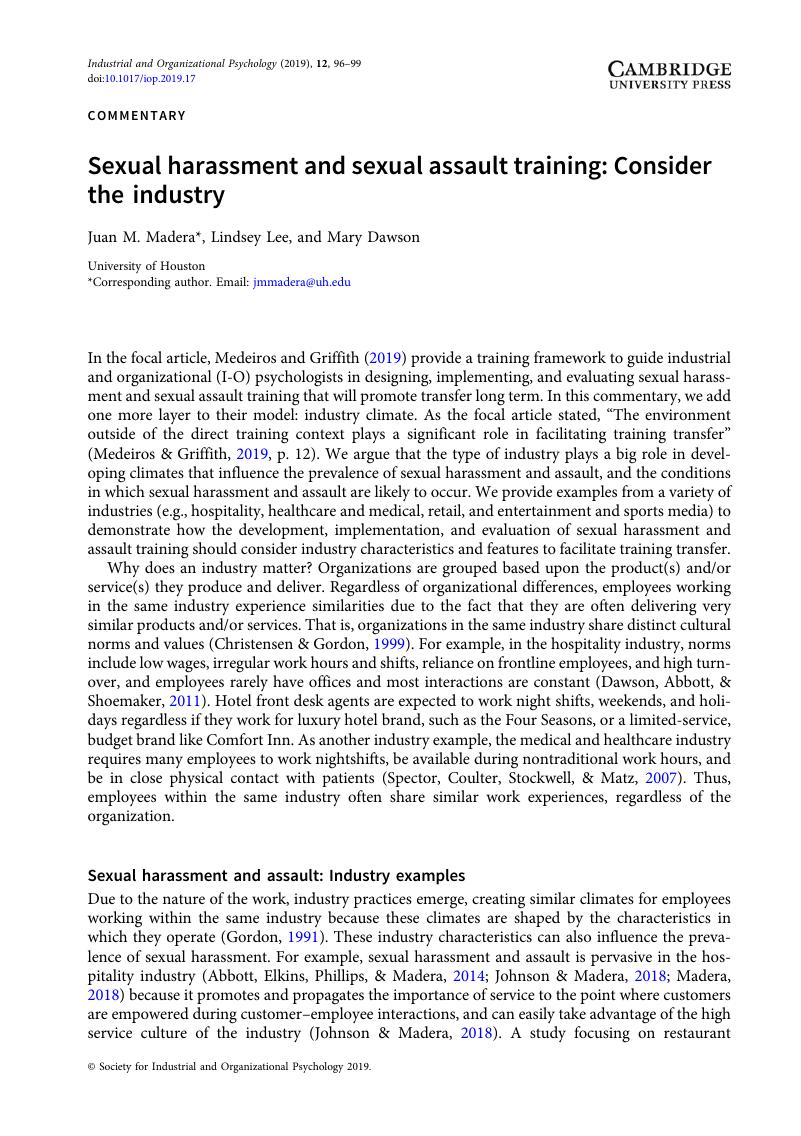Crossref Citations
This article has been cited by the following publications. This list is generated based on data provided by Crossref.
Latham, Jillian Anne
2020.
Looking beyond training as a solution to workplace sexual harassment and discrimination.
Industrial and Organizational Psychology,
Vol. 13,
Issue. 2,
p.
168.
Burrell, Darrell Norman
Shufutinsky, Anton
Duncan, Terrence D.
Springs, Delores
McLester, Quatavia
and
Mozes, Rebecka
2021.
Handbook of Research on Multidisciplinary Perspectives on Managerial and Leadership Psychology.
p.
300.
Yu, Heyao
Lee, Lindsey
and
Madera, Juan M.
2021.
Collecting Repeated Data Over Time: Applying Experience Sampling Methodology to the Hospitality Management Context.
Cornell Hospitality Quarterly,
Vol. 62,
Issue. 1,
p.
62.
Reguera, Consuelo
and
García-Izquierdo, Antonio L.
2021.
Women as Victims of Court Rulings: Consequences of Workplace Harassment in the Hospitality Industry in Spain (2000–2016).
Sustainability,
Vol. 13,
Issue. 14,
p.
7530.
Pearlman, David M.
and
Bordelon, Bridget M.
2022.
How the #MeToo movement affected sexual harassment in the hospitality industry: A U.S. case study.
International Journal of Hospitality Management,
Vol. 101,
Issue. ,
p.
103106.
Dawson, Mary
Russen, Michelle
Lee, Lindsey
and
Madera, Juan
2023.
The Unique Aesthetics of Organizational Climate that Contribute to the Prevalence of Sexual Harassment Incidents within the Restaurant Industry.
Journal of Foodservice Business Research,
Vol. 26,
Issue. 4,
p.
549.
Zhu, Hong
Ye, Yijiao
Zhou, Mingjian
and
Li, Yaoqi
2023.
The impact of customer sexual harassment on customer-oriented OCB: a social exchange perspective.
International Journal of Contemporary Hospitality Management,
Vol. 35,
Issue. 12,
p.
4555.
Strom, Phoebe
Collins, Christopher J.
Avgar, Ariel C.
and
Ryan, Katherine
2023.
Drawing the line: How the workplace shapes the naming of sexual harassment.
Personnel Psychology,
Vol. 76,
Issue. 1,
p.
113.
Nuñez, Imanol
and
Ollo-López, Andrea
2024.
Beyond the headlines: understanding the organizational dynamics of sector-specific sexual harassment.
International Journal of Manpower,
Mousa, Mohamed
Abdelgaffar, Hala
Salem, Islam Elbayoumi
Chaouali, Walid
and
Elbaz, Ahmed Mohamed
2024.
From harasser tourists to above the law managers: female tour guides strategies for coping with sexual harassment.
Asia-Pacific Journal of Business Administration,
Vol. 16,
Issue. 4,
p.
958.
Lee, Heeyoung
Moon, Soo-Yeon
and
Lee, Na-Young
2024.
Industry Culture Matters: Sexual Harassment in the South Korean Film Industry.
Violence Against Women,
Vol. 30,
Issue. 15-16,
p.
4080.



